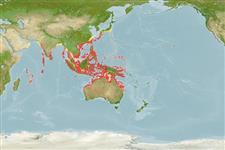| Native range | All suitable habitat | Point map | Year 2100 |

|
| This map was computer-generated and has not yet been reviewed. |
| Lates calcarifer AquaMaps Data sources: GBIF OBIS |
Length at first maturity
Lm ?, range 29 - 60 cm
人類使用
漁業: 高經濟性; 養殖: 商業性; 游釣魚種: 是的; 水族館: 公眾的水族館
Phylogenetic diversity index
(Ref. 82805)
PD50 = 0.5006 many relatives (e.g. carps) 0.5 - 2.0 few relatives (e.g. lungfishes)
營養階層
(Ref. 69278)
3.8 ±0.60 se; Based on food items.
回復力
(Ref. 69278)
中等的, 族群倍增時間最少 1.4 - 4.4年 (K=0.09-0.13; tm=1-5; Fec = 15,300,000)